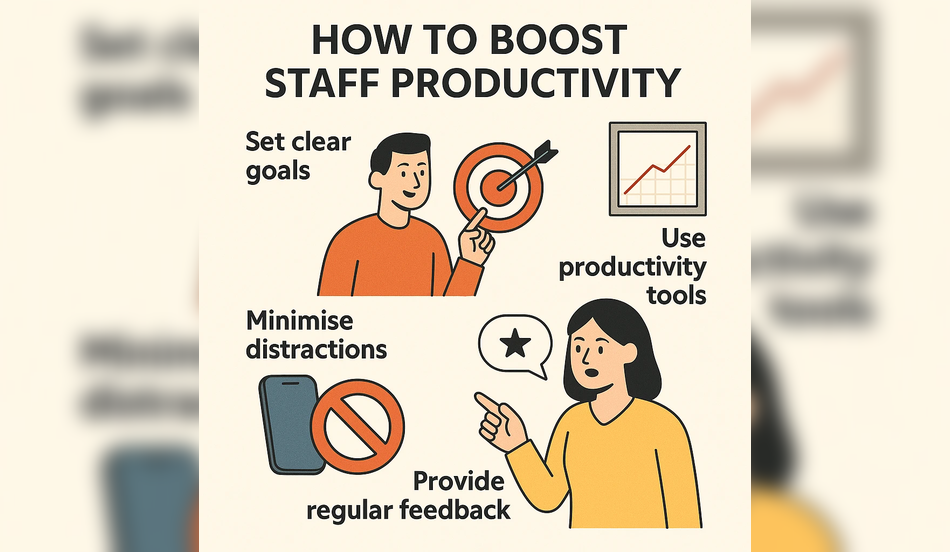Boost staff productivity is a top priority in today’s competitive business environment. Productive employees are the engine behind innovation, performance, and sustainable growth. But increasing productivity isn’t about pushing your team to work longer hours. it’s about implementing smarter, research-backed strategies. In this guide, we’ll explore practical ways to enhance your team’s efficiency, motivation, and results.
Table of Contents
Introduction: Why Staff Productivity Matters
High staff productivity leads to better customer experiences, increased profitability, and higher employee satisfaction. According to a report from McKinsey, organisations with highly productive employees are 40% more profitable. By fostering a culture that supports focus, engagement, and continuous improvement, employers can unlock their team’s full potential.
Step-by-Step Guide to Boosting Staff Productivity
1. Set SMART Goals Aligned with Business Objectives
Clearly defined goals are essential for productivity. Use SMART criteria (Specific, Measurable, Achievable, Relevant, Time-bound) to guide individual and team objectives. This creates clarity and helps prioritise tasks.
2. Identify and Eliminate Productivity Barriers
Conduct surveys or meetings to identify common workplace distractions or inefficiencies, such as unnecessary meetings, unclear roles, or outdated processes.
Tip: Try the Eisenhower Matrix to help staff prioritise urgent vs. important tasks.
3. Equip Teams with the Right Tools
Tools like Slack, Notion, and Google Workspace improve communication, collaboration, and task management. The right tech stack reduces friction and streamlines workflows.
4. Promote Autonomy and Accountability
Empowered employees perform better. Provide guidance but avoid micromanagement. Encourage ownership of outcomes through weekly check-ins and transparent metrics.
5. Offer Training and Development Opportunities
Continuous learning keeps employees engaged and productive. Offer access to platforms like LinkedIn Learning or internal knowledge sharing.
Example: Use a quarterly learning stipend to promote self-directed growth.
6. Recognise and Reward Performance
Recognition boosts morale and productivity. Celebrate wins in team meetings or through digital shoutouts. Implement formal reward schemes tied to output, not hours worked.
Common Pitfalls That Reduce Productivity
- Over-scheduling: Too many meetings can interrupt flow and drain energy.
- Lack of clarity: Vague job roles or responsibilities create confusion.
- Poor communication: Inconsistent messaging leads to errors and delays.
- Burnout culture: Excessive workloads without breaks reduce long-term productivity.

Real-World Examples and Case Studies
- Salesforce UK: Increased productivity by encouraging flexible schedules and remote work.
- Basecamp: Adopted async communication and fewer meetings to boost deep work.
- Airbnb: Launched employee-led innovation weeks to drive creativity and problem-solving.
Recommended Tools and Platforms
- Trello: Visual project management and task tracking.
- 15Five: Weekly check-ins and performance analytics.
- RescueTime: Tracks digital habits and highlights productivity trends.
- Loom: Enables asynchronous video communication.
Conclusion
Boosting staff productivity requires a thoughtful blend of structure, support, and adaptability. When you invest in goal clarity, efficient systems, and employee well-being, you empower your team to deliver their best work consistently. Ready to implement proven strategies that get results? Explore more expert tips at our Career Advice Hub and start building your productivity plan today.
Frequently Asked Questions (FAQ)
Q1: What is the most effective way to increase employee productivity?
Start by setting clear, achievable goals, eliminating time-wasters, and providing the tools and training needed for success. Recognition and autonomy also play major roles.
Q2: How do you measure staff productivity?
Use KPIs tied to output, deadlines, and quality metrics. Tools like 15Five and Clockify help quantify performance while gathering team feedback.
Q3: Can remote work boost productivity?
Yes—if supported with the right tools and trust. Flexible work policies have been shown to reduce stress and increase focus, leading to better results.
Q4: What are quick wins to improve productivity?
Declutter digital tools, reduce unnecessary meetings, implement task priorities, and acknowledge daily achievements. Small changes create big momentum.






